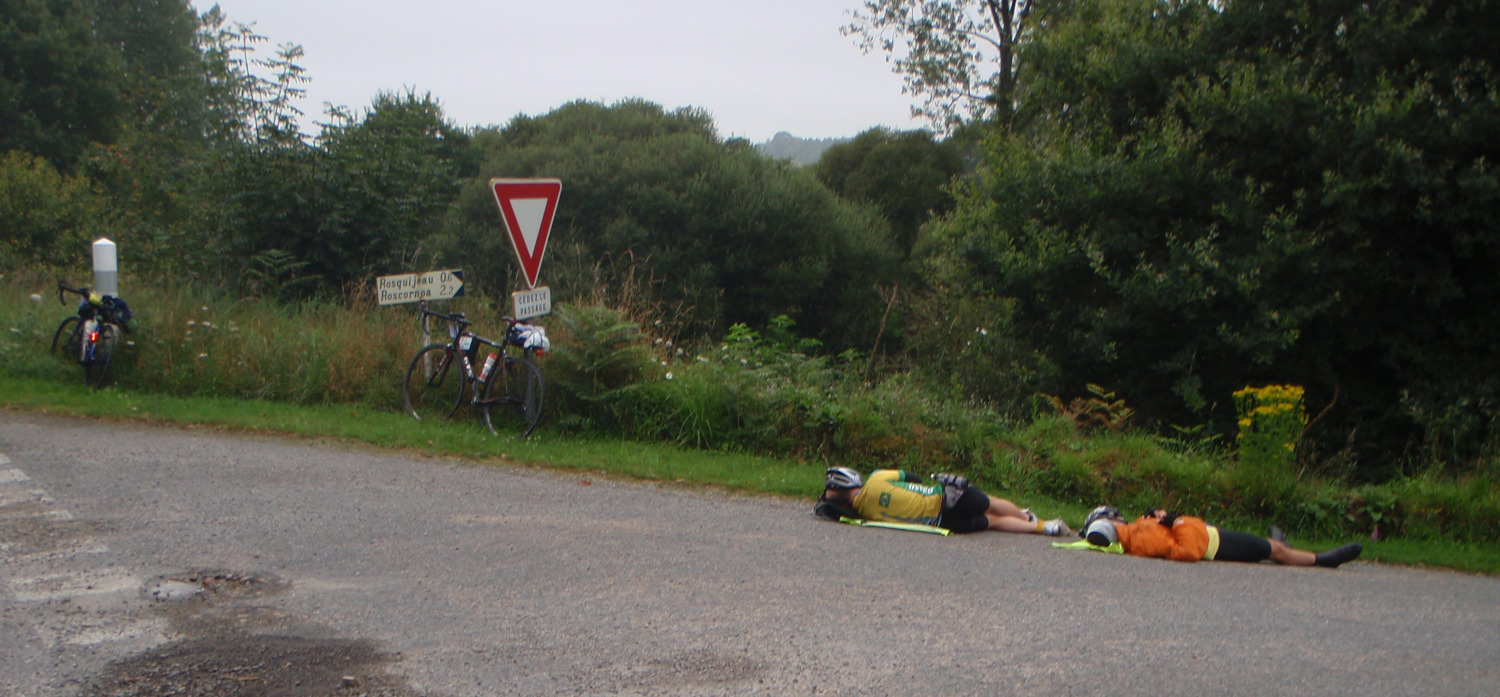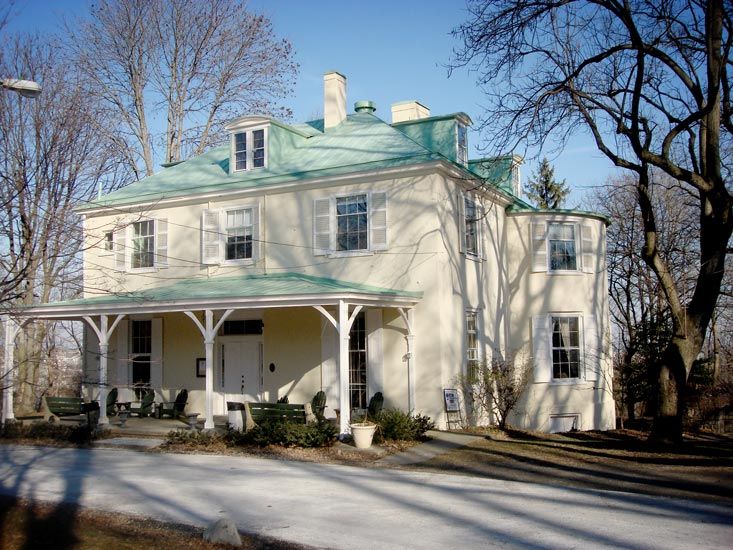The third event of the 2023 Super Randonneur Series, the Four State 400, and the Chamounix Classic 200 are in the books. The report for the 200, written by organizer Chris Nadovich, is located below the 400 report.
Four State 400 Ride Report
24 riders clipped in for the 400 on a warm and humid morning, with rain on the way. Of those 24, 20 finished the challenging route. Along with the two pre-riders, we had a total of 22 finishers and a finish rate of 85%. Congratulations and well-done! It was a valiant effort by all riders. Please take a look at the preliminary results and let me know if anything does not look right. The results will be submitted to RUSA after review and will become official once certified.
The nerves were palpable at the start. Not because of the wet weather that was forecasted. That was nothing, as many of these riders had dealt with some kind of unruly weather earlier this spring, from torrential and unrelenting rains to tornado warnings and hail. The nerves were due to the amount of climbing they knew was coming. The route involved over 16,000ft of climbing, including several hills with intimidating grades. In an attempt to calm the nerves, the pre-riders offered their advice of using the descents to relax for a few moments, eating at every control, and enjoying the scenery as a distraction.
 |
| Marcus Mommen had his Bird-in-Hand postcard ready to go. (Photo by Marcus Mommen) |
Riders loaded their packs with snacks such as ham sandwiches, leftover pizza, sports bars of all kinds, Cheez-Its, Uncrustables PB&J, Swedish Fish, and bags of spaghetti. Others kept their loads light and planned to stop at the numerous Wawas and Turkey Hills along the route.
 |
| Tommy Green rides on a damp Lancaster road. (Photo by Ello Shertzer) |
After a dry start, there was a light rain that persisted throughout the rest of the morning. The only weather-related issue reported was the messiness of some roads in Lancaster, as the roads frequented by horse carriages were covered in wet horse buns. Once riders reached the Schuylkill River around the halfway point, the rain subsided. Riders either had to dry off or layer up by the time the sun went down and temperatures dropped.
Rider Iwan Barankay experienced a busted rear derailleur cable near the Hockessin DE control. Despite help rendered by an experienced bike mechanic who was along on the ride, Iwan was only able to rig his gears to use the 14 tooth cog of his cassette with his two chainrings in the front (46/30). This made for some tough riding on the hilly route. Chapeau Iwan!
 |
| Greg Lang and his fixie with no brakes |
Another rider impressed everyone with his completion of the event with limited gearing. As he has on the other rides of this SR Series, Greg Lang rode a fixed gear bike with no brakes. Not only did he tackle the course successfully, but he was the first finisher! Greg had to climb up the steep ascents with only one gear and then was not able to enjoy the reward and relax on the long descents like everyone else. Riders and volunteers were blown away by his strength and ability to safely navigate his bike without brakes through a ride that lasted all day and well into the night. Chapeau Greg!
An impressive number of riders completed their first 400k: Nicole Aptekar, Tristan Dahn, Annie Gibson, Jeryl Jamir, Chris Kline, Bryce Lackey, Greg Lang, Marcus Mommen, and Ello Shertzer. Congratulations to all! Jeryl not only completed his first 400, it was also his first brevet. What a brevet to pick for your first one! He left no doubt about his ability to ride and climb. Chapeau!
 |
| Pat and Cece Gaffney (Photo by Gavin Biebuyck) |
There were quite a few experienced randonneurs in the pack who added another 400k to their resume: Iwan Barankay, Travis Berry, Gavin Biebuyck, Adam Bowen, Alex Estes, Cece and Pat Gaffney, Tommy Green, Ben Keenan, Bill Scanga, Ryan Stanis, Ben Thompson, and yours truly. They helped the rookies along the way with advice and steady hands, and legs.
 |
Riders enjoying pro-level support from Amy and Anton at the Bloomsbury control. From left to right: Chris, Annie, Bill, and Adam. (Photo by Anton Lindberg)
|
Randonneurs Amy Lippe and Anton Lindberg volunteered for the event and met riders at the Citgo Bloomsbury NJ control (around 300k). Having support from experienced randos like Amy and Anton at this point in the ride was critical. Darkness was setting in and riders were beginning to feel the toll of the climbs. Once riders filled their bottles and received their pep talks, they headed out to conquer the final big climb of the day on Staats Road. Amy was going to take part in the pre-ride but unfortunately came down with a cold the day before the ride. We hope to see her on the 600 next month.
Several experienced riders, Mario Claussnitzer, Wilson Wilson, and Kate Sparacio, abandoned the ride before the halfway point, knowing they weren’t feeling it. It takes wisdom from lots of experience to be able to make that call. Rider Sophia Lofaso abandoned in Doylestown (with about 30 miles to go) as they experienced difficulty keeping their eyes open. Understandably, Soph expressed disappointment afterwards and realized that there was enough time left for a ditch-nap. However, we know that Soph has the strength to complete this kind of ride and this experience will fuel their motivation in the next brevet. Soph should also be proud of completing almost all of the climbing of this route since there wasn’t much climbing left after Doylestown.
Thank you to all of the volunteers who helped make this a successful event. Chris Nadovich, the club RBA, helped with the route and event planning process, and helped with the start and finish of the event. He even found time to ride the Chamounix Classic 200k in between. Ben Keenan participated in the pre-ride and then drove to Philly in the early morning hours to help with the start of the event. Ben is an excellent partner to have on a challenging pre-ride. Iwan Barankay helped with event planning (while organizing all the other SR Series rides!). Phil Mitchell drove in to help with the finish - we hope to see him as a participant in a brevet someday soon. Bill Olsen was on standby in New Jersey in case anyone needed support. And thank you again, Amy and Anton, for providing crucial support along the course. David Coccagna helped with setting up the food and drinks for the finish. Many riders helped with cleanup on Sunday: Ello Shertzer, Alex Estes, Jeryl Jamir, Nicole Aptekar, and Soph Lofaso. Thank you to Gavin Biebuyck for tagging along with me on one of the course scouting rides over the winter and helping to improve the navigation through Oley Valley. If I forgot anyone, I apologize - please let me know and I will add your name to the report.
Join us again on June 3 for the grand finale of the SR Series, the Jim Thorpe 600, and on June 4 for the Tscheschter Kaundi 200. These rides will again start and finish from the Chamounix Hostel in Philadelphia. Details and registration are on the PA Rando website.
 |
Remember that Rando Cat will always be waiting for you at the finish.
|
Chamounix Classic 200 Ride Report, by Chris Nadovich:
Three hours after the 400K riders departed, the 200K set out at the much more civilized start time of 7AM. The course was the "Chamounix Classic", which was the first full brevet course we ever developed for a Philadelphia start/finish, and first ridden at the edge of COVID. Iwan did most of the route design for this. It's a true classic.
I had forgotten how beautiful this route is. It exits the city through lightly travelled residential roads through the Main Line, which is a very welcome change from Manayunk or the Northeast. There was a light drizzle falling for most of the morning, but this did not detract from the beauty, especially from Goshen Rd on through Chester Springs. I rode with Ken Cappel for some miles, and he commented that it was the best smelling ride he had done in a while, what with the lilacs, honeysuckle, and other fragrant flowers in full bloom.
All was well till we reached the Perkiomen Trail. There we discovered the entrance was closed as the bridge over the Perkiomen Creek was under construction. Who knew? This is the sort of problem that crops up when there's no pre-ride. In any case, riders all seemed to find their ways around the impassable bridge, only to puzzle at the ambiguous info control question immediately beyond.
Then it was trail riding for many, many miles. Much of the Perk trail was once paved with non-newtonian fluids resembling sand and gravel but with significantly more magical properties that would suck wheels this way and that. Most of that is now gone, replaced with solid blacktop. I have mixed feelings about the "improvement" as it has attracted more walkers, ebikes, roller bladers, and baby carriages.
When I reached the SRT, I rode with a bike tourist who had started in Key West this past April and was headed to Portland -- first ME then OR. As we rode past the "fragrant" sewage plant I thought of Ken Cappel's previous comment about the smells on this brevet.
The final bit of trail in the route took us over Forbidden Drive along the Wissahickon. I think all the magical wheel-bewitching material from the old Perk trail was moved to Forbidden Drive and mixed with an equal part of 3-inch rock fill. What a decidedly UN-pleasant riding surface! The only bit of enjoyment I experienced on FD as my sore butt bounced down that path was when I barged into a wedding celebration spread across the trail in Valley Green.
After that it was the last little grunt up to Chamounix where I was greeted by Brad Layman who was staffing the 200K finish. Thank you SO MUCH Brad for your excellent work organizing the 400K and also helping with the 200K.
 |
| Mike Reali Jr at the 200 finish |
Looking over the finish sheet I was happy to see several riders who completed their first 200K. Sara Johnson, Jonas Schaller, and Michael Moote (who previously rode a 400K but nothing shorter?!)













